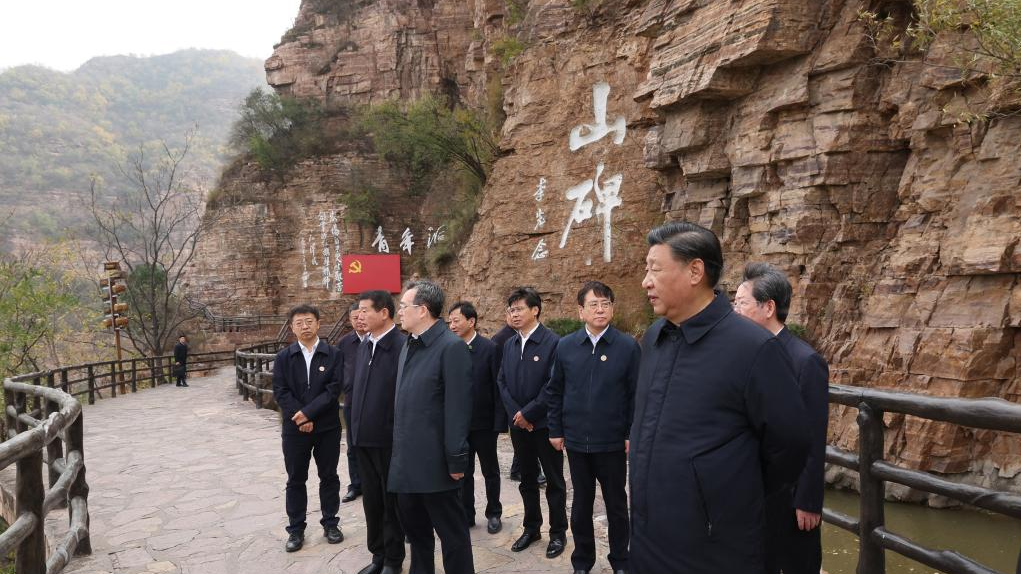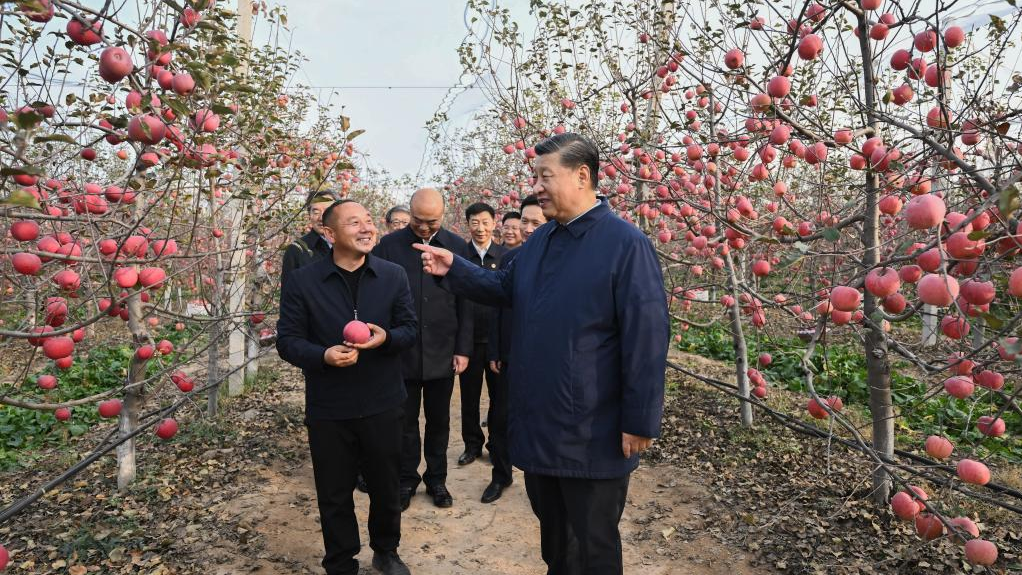
Xi Jinping, with the members of the Standing Committee of the new CPC Central Committee Political Bureau, views the Hongqi Canal in Linzhou City, Henan, China, October 28, 2022. /CFP
Xi Jinping, with the members of the Standing Committee of the new CPC Central Committee Political Bureau, views the Hongqi Canal in Linzhou City, Henan, China, October 28, 2022. /CFP
Editor's note: Song Yuehong is deputy director and research fellow at the Institute of Contemporary China Studies of the Chinese Academy of Social Sciences. The article reflects the author’s opinions and not necessarily the views of CGTN.
Advancing the rejuvenation of the Chinese nation on all fronts through a Chinese path to modernization is a solemn declaration made by the Communist Party of China (CPC) at its 20th National Congress on the mission and tasks of the new journey in the new era. Just a few days after the Congress, Xi Jinping led members of the Standing Committee of the new CPC Central Committee Political Bureau on a visit to Yan'an, Shaanxi Province, and Anyang, Henan Province.
During the visit, he pointed out that "the most challenging and arduous tasks we face in building a modern socialist China in all respects remain in rural areas." His statement points not only to the reality on which Chinese modernization is based, but also the strategic role and significance of agriculture and rural areas in Chinese modernization. The 20th National Congress reaffirmed the priority given to the development of agriculture and rural areas, and for the first time explicitly proposed "accelerating the process of building China into a country strong in agriculture." Modernization of agriculture and rural areas is the source of impetus and strategic foundation of Chinese modernization for the following reasons.
First, modernization of agriculture and rural areas is an important historical foundation for Chinese modernization. Historically, China established itself as an agricultural country, and has only gradually embarked on the journey of industrialization after the founding of the People's Republic of China (PRC) in 1949, while agricultural development remains an important component of national economic and social development. The founding of the PRC and the cause of socialist modernization are the result of the correct path led by the CPC in advancing from rural areas to cities, becoming the leading party, and winning the victory of the new-democratic revolution (1919-1949).
Yan'an, the first stop of Xi Jinping's recent visit, is the cradle of the PRC. It was from there that the Party led the people to achieve a breakthrough of the Chinese revolution with only a modest arsenal. It was based on agriculture that the country started its cause of the "four modernizations" after the founding of the PRC. During his visit to the Hongqi Canal in Linzhou, Anyang, Henan Province, Xi Jinping emphasized that "the Hongqi Canal is a monument."
The Hongqi Canal is a water conservancy project built in the 1960s in the Taihang Mountains to divert the Zhanghe River into Linzhou to mitigate frequent droughts in the area. Local people called it an "artificial heavenly river." China's history and national conditions have fully demonstrated that without the modernization of agriculture and rural areas, there would have been no modernization of the whole country or Chinese modernization.

Xi Jinping, with the members of the Standing Committee of the new CPC Central Committee Political Bureau, chats with local villagers in an orchard in Nangou Village of Yan'an, Shaanxi, China, October 26, 2022. /CFP
Xi Jinping, with the members of the Standing Committee of the new CPC Central Committee Political Bureau, chats with local villagers in an orchard in Nangou Village of Yan'an, Shaanxi, China, October 26, 2022. /CFP
Second, modernization of agriculture and rural areas is key to national rejuvenation on all fronts. Revitalizing rural areas is central to achieving the great rejuvenation of the Chinese nation. Agriculture and rural areas are a solid foundation for safeguarding China's sovereignty, national security, and development interests. A prosperous agriculture and stable and orderly rural areas will promote national unity, social stability, and economic prosperity. Food security is the lifeline of the people.
When the CPC ensures that Chinese people hold the rice bowl firmly in their own hands, it is in a safe position to ensure people's well-being and social stability and to remain resilient to various risks and challenges from the natural world and human society alike. A key move to achieve national rejuvenation, the reform and opening-up policy, also stemmed from the Party's efforts to liberate and develop productivity and promote the overall progress of rural areas to support industrialization. Poverty eradication is a central task in building a well-off society in all aspects. To this end, the Party has led the people to adhere to targeted poverty alleviation and won the largest battle against poverty in human history, with nearly 800 million rural people lifted out of poverty and with absolute poverty eradicated in China.
During his recent visit to Shaanxi and Henan, Xi Jinping visited orchards, water projects, and exhibitions to see "what people's lives look like after getting rid of poverty, what difficulties they still have, and how to advance revitalization of rural areas." The rural areas, after poverty eradication, will be built into a well-off society together with the cities, and on this basis, revitalization will be comprehensively promoted. Modernization of agriculture and rural areas is an important component and a driving force of Chinese modernization. The Chinese nation has realized the millennium dream of being well-off, and the national rejuvenation will have brighter prospects.
Third, modernization of agriculture and rural areas is the necessary path to achieving common prosperity for all. Common prosperity is the essential requirement of socialism with Chinese characteristics, and Chinese modernization is the modernization to bring common prosperity for all. The magnitude and complexity of modernization with a large population mainly lie in agriculture and rural areas. Despite significant progress in agriculture and rural areas, there will remain quite a gap between rural and urban areas in the years to come.
To accelerate modernization of agriculture and rural areas, we need to give them priority, carry forward the spirit of Yan'an and the spirit of the Hongqi Canal, and promote coordinated development of urban and rural areas and regional integration. It is also important to improve the socialist market economy system, promote a new development pattern, build a modernized economic system, accelerate high-quality economic development to make new breakthroughs and significantly improve capabilities for self-reliance in technological advancement.
Further efforts will be made to enrich people's leisure and cultural lives, promote equal access to basic public services, improve the multi-level social security system and make communities more habitable for urban and rural residents. It is essential to maintain and promote social justice, prevent income polarization among the people, let more fruits of modernization benefit all more fairly, promote common prosperity for all and realize people's aspirations for a better life.
(If you want to contribute and have specific expertise, please contact us at opinions@cgtn.com. Follow @thouse_opinions on Twitter to discover the latest commentaries in the CGTN Opinion Section.)